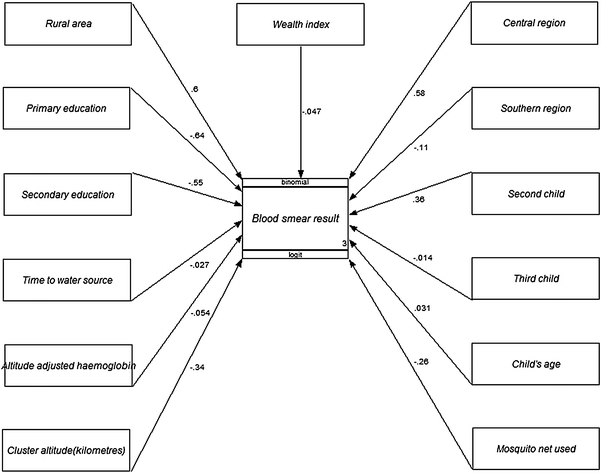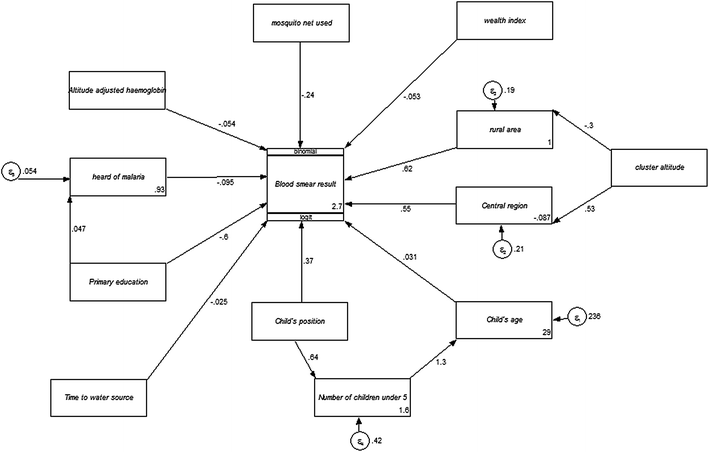Direct and indirect determinants of childhood malaria morbidity in Malawi: a survey cross-sectional analysis based on malaria indicator survey data for 2012
- PMID: 26152223
- PMCID: PMC4495946
- DOI: 10.1186/s12936-015-0777-1
Direct and indirect determinants of childhood malaria morbidity in Malawi: a survey cross-sectional analysis based on malaria indicator survey data for 2012
Abstract
Background: Children under the age of five are most vulnerable to malaria (malaria is a major health challenge in sub-Saharan Africa) with a child dying every 30 s from malaria. Hampered socio-economic development, poverty, diseconomies of scale, marginalization, and exploitation are associated with malaria. Therefore establishing determinants of malaria in affected sub-Saharan populations is important in order to come up with informed interventions that will be effective in malaria control.
Methods: The study was a cross-sectional survey design based on data from the Malawi 2012 Malaria indicator Survey obtained from Demographic and Health Survey (DHS) programme website. The outcome variable was positive laboratory-based blood smear result for malaria in children less than 5 years, after an initial positive rapid malaria diagnostic test done at the homestead. Statistical modelling was done using survey logistic regression as well as generalized structural equation modelling (G-SEM) to analyse direct and indirect effects of malaria.
Results: The propensity score matched data had 1 325 children with 367 (27.7%) having blood smear positive malaria. Female children made up approximately 53% of the total study participants. Child related variables (age, haemoglobin and position in household) and household wealth index were significant directly and indirectly. Further on G-SEM based multivariable analysis showed socio-economic status (SES) [Odds ratio (OR) = 0.96, 95% Confidence interval (CI) = 0.92, 0.99] and primary level of education [OR = 0.50, 95% CI = 0.32, 0.77] were important direct and indirect determinants of malaria morbidity.
Conclusion: Socio-economic status and education are important factors that influence malaria control. These factors need to be taken into consideration when planning malaria control programmes in order to have effective programmes. Direct and indirect effect modelling can also provide an alternative modelling technique that incorporates surrogate confounders that may not be significant when modelled directly. This holistic approach is useful and will help in improving malaria control.
Figures


References
-
- Mhalu FS. Burden of diseases in poor resource countries: meeting the challenges of combating HIV/AIDS, tuberculosis and malaria. Tanzan Health Res Bull. 2005;7:179–184. - PubMed
-
- Dzinjalamala F (2009) Epidemiology of malaria in Malawi. Malaria in Malawi (http://www.medcol.mw/commhealth/publications/epi%20book/Malaria%20chapte...)
-
- WHO (2004) Malaria and HIV/AIDS interactions and implications: conclusions of a technical consultation convened by WHO. World Health Organization, pp 23–25
-
- Casella G, George EI. Explaining the Gibbs sampler. Am Stat. 1992;46:167–174.
Publication types
MeSH terms
LinkOut - more resources
Full Text Sources
Other Literature Sources
Medical

